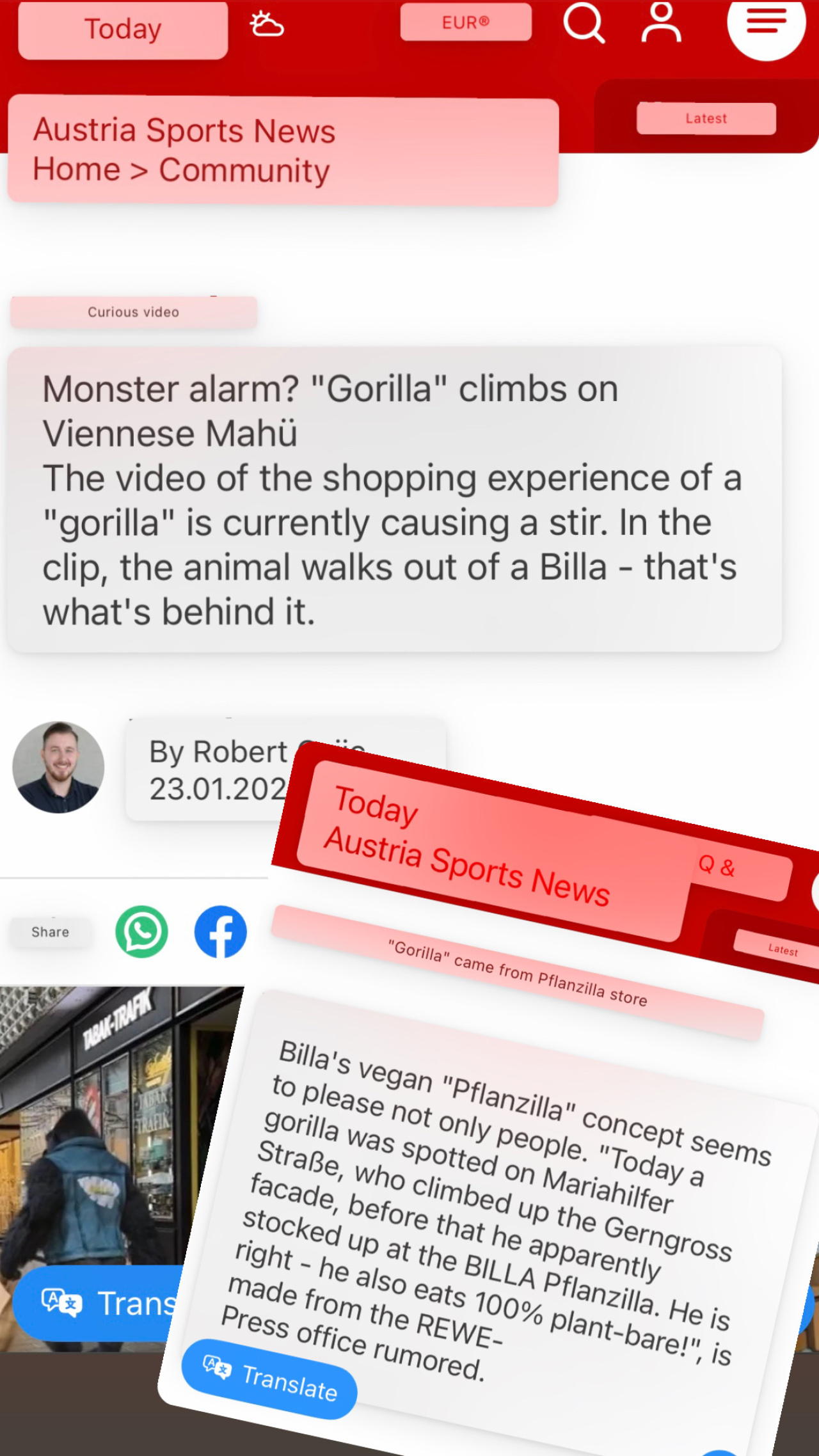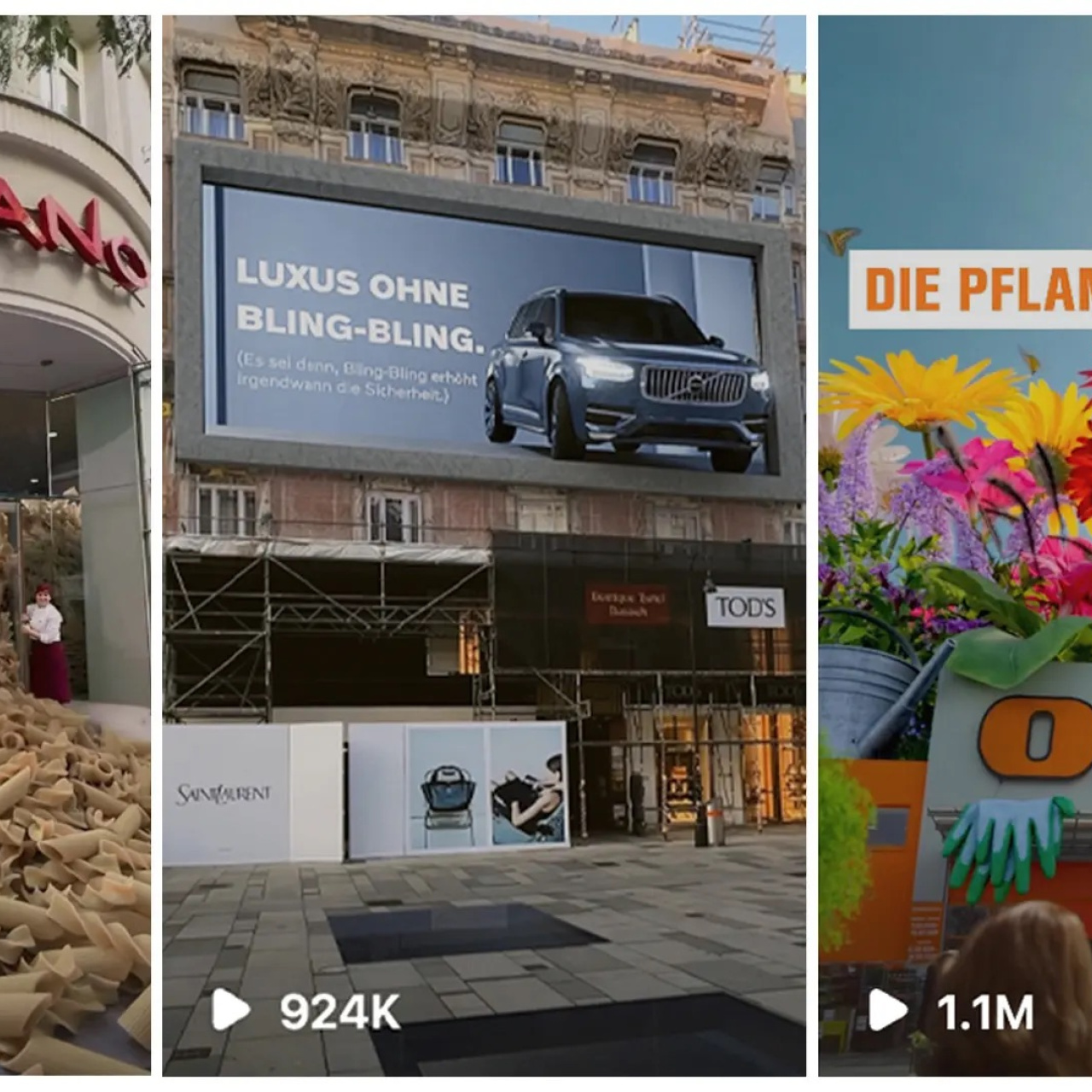With modern technology, marketers and brands hold a wealth of information at their fingertips when it comes to measuring the success of their advertising campaigns. Although not traditional and relatively new, measuring a Fake Out of Home or FOOH ad success is no exception.
After all, if you do it right, FOOH ads can be a powerful tool in any marketer's toolbox. It can bring you a whopping number of impressions and engagement and get people talking about your brand.
But what exactly is a FOOH ad? And, how do you know if your FOOH ad campaign is delivering the results you want? This guide will explore 29 essential metrics and tips to help you measure and improve your FOOH ad success. Let's take a look.
Want to know everything there is to know about Fake Out of Home ads? Check our 2025 guide here.
What is a Fake Out of Home ad?
Fake Out of Home, or FOOH, is a type of short-form video advertising that combines CG 3D elements with real-life footage of popular locations and landmarks. You'll often see these ads on TikTok, Instagram or Meta reels, and YouTube dhorts.
When done right, Fake Out of Home ads (when done right) create such a seamless blend of the real and the 3D elements that you'll often see a barrage of online comments asking, "Chat, is this real?"(It's not.) Sometimes, the disbelief and absurdity are so out of this world that even news outlets will pick up on these ads, not realizing it's a marketing ploy.
Just take a look at this FOOH ad from Volvo Austria. A car is being driven out of an underground freeway, where it appears in a garage that seems to be installed on the wall of a second-story building. People were asking our team at Rendersnek how long this installation would be up in Vienna!
Marketing campaigns take work, and marketers and brands know that. From its conception to the execution of each ad, every piece is carefully curated to fit the brand's specific purpose and goal. And planning your campaign and FOOH ad success are no different.
Before launching your FOOH campaign, it is crucial to identify your primary objectives and how FOOH ad success is supposed to look for your business. Do you want to raise brand awareness? Increase social media engagement and followers? Or generate leads for your business?
Once you've set what you want to achieve, it's time to make those goals SMART. Specific, Measurable, Achievable, Relevant, and Time-bound. For example:
Specific - Instead of saying "Increase brand awareness," be more precise: "Increase brand awareness by 25% within the next month."
Measurable - Use KPIs (Key Performance Indicators) to track your goals.
Achievable - Make sure your goals are realistic and achievable with the resources you have. Instead of aiming for a 100% increase in website traffic from clicking a unique link on your FOOH ad post, consider a more achievable goal of 50%.
Relevant - If generating leads is your main objective in measuring FOOH ad success, focus on metrics directly related to this goal. Track the number of users who click the link in your ad and fill out a lead form on your website.
Time-bound - For a goal to be achievable, it must have a deadline. Set a specific timeframe for achieving your goal. For instance, aim to see a 50% increase in website traffic from the FOOH ad link within three months. This provides a clear deadline, allowing you to track progress and adjust as needed to stay on target.
Measuring FOOH Ad Success: 16 Key Metrics
KPIs are essential for measuring the success of any marketing campaign. They help you understand what's working and what needs improvement in your campaign, which is crucial for measuring FOOH ad success. KPIs also provide valuable insights into your target audience and their behavior, giving you the information you need to optimize your campaign for better performance.
Depending on which platform you use for your FOOH ads, some of the metrics will be available to measure directly from the platform's analytics dashboard. For others, you may need to use third-party tools or manual calculations to track these metrics.
Here are 16 key metrics that you should consider when measuring FOOH ad success:
Conversion Metrics:
1. Lead Generation Rate
The lead generation rate is the percentage of people who view your ad and take action. This could mean clicking a unique link to your website or filling out a form.
Tracking leads generated from your ad is an excellent way to measure the FOOH ad success in generating potential customers for your business. Because this metric is more specific to your business goals, it can give you a better understanding of the impact of your FOOH ad campaign.
2. Conversion Rate
Apart from lead generation, you should also track the overall conversion rate of your FOOH ad. This measures the percentage of viewers who take a desired action, such as making a purchase or signing up for a service.
Here's an example: If your marketing campaign's goal received 100 new leads, but none of them converted into customers, then it may be time to tweak your ad. Your FOOH ad may have received interest, but its message may haven't resonated with your target audience.
Want to know what makes a FOOH ad successful? Read our: 5 Top Tips on Avoiding Common Fake Out of Home Ad Mistakes to learn more.
3. Cost per Lead (CPL)
The cost per lead is the amount of money you spend to generate one lead. For example, if your FOOH ad campaign costs $100 and generates 50 leads, then your cost per lead is $2. This metric helps you determine the efficiency of your marketing efforts and can guide future budget allocations.
4. Cost per Acquisition (CPA)
Another important metric to consider when measuring FOOH ad success, the CPA is the average cost you spend to acquire a new customer. This includes all the costs associated with your FOOH campaign, including ad creation, ad placement fees, and additional expenses. A lower CPA indicates higher efficiency in acquiring new customers through your marketing efforts.
Engagement Metrics:
5. Social Media Likes, Shares, and Comments
Engagement is a crucial aspect of FOOH ad success. The more people talk about your ad, the better its reach and potential impact.
Tracking likes, shares, and comments on social media platforms like TikTok, Meta, and Instagram can show how well your ad resonates with your viewers and target audience. This metric can also help you identify any changes or updates that could improve the engagement on your FOOH ad.
6. Video Completion Rate
How many people watch your entire FOOH ad? Do people skip it after a few seconds, or do they watch until the end?
Tracking your video completion rate can give you insight into how effective the content of your FOOH ad is. If your completion rate is low, meaning people aren't watching your whole ad, that can tell you that your hook might be strong, but your ad's middle, end, and overall message may need improvement.
Here's a guide on How to make effective and viral FOOH ads that sell.
7. Click-Through Rate (CTR)
Simply put, the CTR is the percentage of viewers who clicked on your ad. This metric can show how well your FOOH ad persuades people to take action, whether it's to visit your website or download an app.
8. Brand Mentions and Hashtags
How many people are talking about your brand after seeing your FOOH ad? Tracking mentions and hashtags related to your ad will let you know how well it's resonating with viewers and if it's creating any sort of dialogue or conversation online.
Reach and Impressions Metrics:
9. Unique Reach
Unique reach refers to the number of individuals who saw your ad at least once. This metric can show how many people were exposed to your brand through your FOOH ad campaign.
10. Impressions
Similar to unique reach, impressions measure the total number of times your ad was shown, including multiple views by the same person. This metric is useful for understanding the overall exposure and potential impact of the FOOH ad success.
Traffic Metrics:
11. Website Traffic
Knowing how many people visited your website after seeing your FOOH ad can give you an idea of its effectiveness in driving traffic, especially if your goal is to increase brand awareness and website visits.
You can track this using unique links or landing pages specific to your ad campaign. This will also help you identify which platforms or channels drive the most traffic to your website.
12. Bounce Rate
The bounce rate measures the percentage of people leaving your website after viewing only one page. A high bounce rate could indicate that your FOOH ad isn't effectively targeting the right audience or that your website needs improvement.
13. Sources of Traffic
Knowing where your website traffic is coming from can help you determine if your FOOH ad is effectively reaching your desired audience. If a huge portion of your traffic isn't coming from social media -- where your ad is placed, it may be time to rethink the messaging or content of your FOOH ad.
Brand Awareness Metrics:
14. Brand Recognition
Tracking this metric means examining the number of times your brand was mentioned before and after the launch of your FOOH ad campaign. This could include social media mentions and tags, articles, news stories that feature your brand, or customer feedback.
15. Brand Sentiment
Brand sentiment refers to people's overall attitude towards your brand. Look at the comments and feedback on your FOOH ad to understand how people perceive your brand.
How do people respond to your ad? Are they excited, intrigued, or uninterested? This metric will help you gain insights into how the FOOH ad success is impacting brand perception and if it aligns with your overall branding strategy.
16. Branded Search Volume
This metric measures the number of people searching for your brand, another critical indicator of FOOH ad success. This metric is worth tracking if your top goal is to increase brand awareness and recognition.
You can track branded search volume through Google Trends or other analytics tools and compare it to the time period before your FOOH ad campaign. An increase in branded searches suggests that your ad has successfully increased brand awareness among your target audience.
Knowing the right tools to track your KPIs is crucial in measuring FOOH ad success. You can make informed decisions and adjustments to your campaign based on data-driven insights, and avoid making calls that could potentially harm your return on investment.
Here are 13 tools you can use to measure your FOOH ad success:
1. Google Analytics
This all-in-one tool is a must-have for tracking website traffic, bounce rate, and traffic sources. The platform offers in-depth data and analytics on website unique visitors, conversions, viewers, and how the FOOH ad success impacts your website's overall traffic.
A great feature of this analytics tool is the ability to set up custom goals and track specific actions that align with your brand and FOOH ad campaign's objectives. For example, if the goal of your campaign is to increase conversions and drive more sales, you can set up a goal for each completed purchase and track the number of conversions from your FOOH ad campaign.
2. Instagram Insights
FOOH ads are placed on social media, and Instagram is one, if not the most popular choice of platform for this type of advertising. Using Instagram's built-in insights, you can track how many people saw, liked, commented, shared, or bookmarked your FOOH ad post.
You can also see how many people interact with your profile after they see your ad. If your goal is to increase brand awareness as part of your marketing campiagn, this tool can be valuable in tracking your progress and FOOH ad success.
Another popular option, Meta's ads manager, is a great tool for tracking FOOH ad success on Facebook and Instagram. This is a fantastic tool, especially if your target audience is on Meta, as it offers in-depth data on reach, impressions, CTR, and engagement metrics like comments and shares.
Another useful feature of this tool is the ability to create custom audiences based on location, demographics, interests, behaviors, etc. This allows for better targeting of your FOOH ads to reach the right audience.
4. TikTok Analytics
TikTok has become an increasingly popular advertising platform, and its short video format aligns perfectly with the nature of FOOH ads. Its analytics dashboard tracks views, likes, shares, comments, and audience demographics for your FOOH ads.
However, it is important to note that if you post your FOOH ad on TikTok, it's not recommended that you do so anywhere else. TikTok's algorithm favors new and unique content, so posting the same ad on multiple platforms may result in lower engagement, so make sure your target audience is primarily on TikTok.
5. Hootsuite Analyze
A platform that also allows you to schedule and publish posts, Hootsuite's Analyze feature provides insights into major social media platforms like LinkedIn, X, Meta Pages, YouTube, and Instagram. This tool also offers a unique feature to track FOOH ad success: impact metric.
This metric provides insights into each social media post's return on investment (ROI), including FOOH ads. You can see how much revenue or conversions your ad generated compared to the cost of running it and track the overall impact of your FOOH campaign.
6. Client Feedback
If you're a marketer or agency running a campaign for a client or brand, their feedback is also crucial in evaluating FOOH ad success. After all, they probably know most about their brand, target audience, and goals.
Make sure to communicate regularly with your clients and gather their direct feedback on the FOOH ad sucess. Schedule regular check-ins with your clients to discuss campaign progress, goals, and any concerns they may have.
Your client's satisfaction with the ad campaign will open your eyes to areas for improvement and ultimately lead to success. It also allows for open communication and collaboration between marketer and client, resulting in a stronger partnership and potentially more successful future campaigns together.
7. Sprout Social
Sprout Social offers a comprehensive social media report for your marketing campaign. This platform allows you to compare how your posts are performing to a competition's, and it can also show you if FOOH ad success is on the horizon. It also allows you to view which campaign, whether it's a contest or a promotion of a new line, impacted your brand awareness the most.
8. Rival IQ
Rival IQ is an all-in-one social media analytics software that can compare your performance and your competitors' FOOH ad success rate across multiple platforms, such as Facebook, Twitter, and Instagram. This tool also provides insights into your audience demographics and engagement rates.
9. Brandwatch
Brandwatch is an analytics tool that helps you understand how your brand is perceived online in real-time. This sophisticated platform can track conversations, mentions, sentiment, and overall reach on various social media platforms, blogs, and articles about your FOOH ad.
Brandwatch also offers you key insights into which influencers might be talking about your campaign. This allows you to identify and potentially collaborate with them to increase FOOH ad success in future campaigns.
10. SEMrush
SEMrush is a marketing analytics tool that tracks your website's performance regarding organic and paid search traffic. You can also use this platform to monitor your competitors' FOOH ad success rate, keywords, and budget for each campaign.
This advanced tool also offers insights into your website's SEO and content strategy, like backlink analysis and keyword rankings. These insights can help you optimize your website for better performance.
11. SurveyMonkey
Gathering feedback from your target audience is an important aspect of measuring FOOH ad success. SurveyMonkey allows you to design and conduct surveys to gather information on what people think about your ad campaign if it resonated with them, and how it impacted their perception of your brand.
SurveyMonkey also offers a Net Promoter Score (NPS) feature, which measures customer loyalty and satisfaction. This can be valuable in understanding if your FOOH ad campaign effectively increases brand loyalty for your target audience.
12. Mention
Mention is another social listening tool that helps you track brand mentions across various platforms in real time. It can help you monitor the impact of your campaign on social media and overall FOOH ad success, and it allows you to engage with potential customers or address any negative mentions.
This tool also offers insights into sentiment analysis, popular hashtags related to your brand, and geographic location of mentions and compares them to your competitors. These insights can help you make data-driven decisions for future FOOH ad campaigns.
13. Buzz Sumo
Buzz Sumo is a content marketing tool that helps you analyze your content's performance and identify top-performing topics, keywords, and influencers in your industry. It can also track social media shares related to your FOOH ad campaign, giving you insights into what content resonates with your audience.
This tool also offers competitor analysis and allows for content ideation based on popular trends and keywords related to your niche or industry. These insights can help you create more impactful campaigns and content and guarantee future FOOH ad success.
Measure, Analyze, and Optimize
As the digital landscape continues to evolve, knowing what data to track and how to analyze it is crucial in measuring the FOOH ad success. Even if you don't see success from your numbers right away, these tools and strategies can help you optimize future campaigns for maximum impact.
Constantly measuring and analyzing data can provide valuable insights into your target audience's behavior and preferences, allowing you to create more effective FOOH ad campaigns that resonate with them.
With time, fine-tuning of your campaign, and consistent analytics monitoring, you can stay ahead of the curve and consistently drive success for your FOOH ad campaigns. So, stay informed, stay updated, and keep optimizing to achieve the best possible results.
Got an idea for a FOOH campaign or interested in implementing one for your brand? Connect with us today and let's make it happen.











